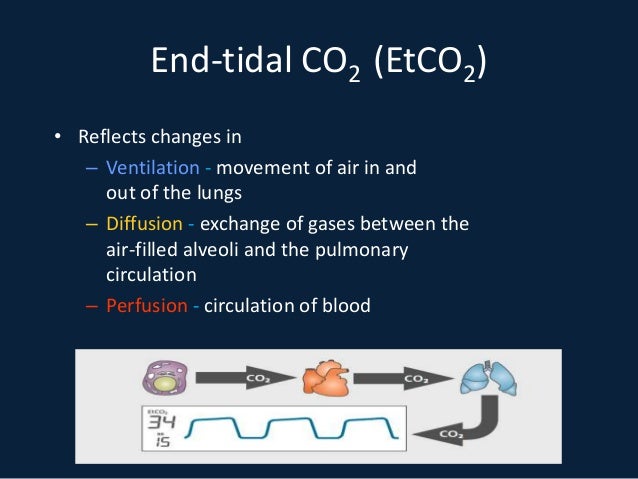low end tidal co2 after intubation
The number is called capnometry which is the partial pressure of CO 2 detected at the end of exhalation ranging between 35 - 45 mm Hg or 40 57 kPa. Association between prehospital cpr quality and end-tidal carbon dioxide levels in out-of-hospital cardiac arrest.

Waveform Capnography In The Intubated Patient Emcrit Project
In the ED we typically think of a EtCO2 as a marker of perfusion and ventilation.

. Consequently a strategy of high-frequency low-tidal volume breaths will tend to achieve less CO2 clearance for any specific total minute ventilation. Ensure proper rate approximately 100min Ensure proper depth with adequate releaserecoil of thorax 12 thorax or minimum 25 inches Persistently low EtCO. A study of blunt trauma patients intubated in the prehospital settings demonstrated that Et co2.
End-tidal carbon dioxide reflects CO 2 concentration of alveoli emptying last. Alveolar dead space may be increased in most types of lung disease reflecting dysfunction at the alveolar vascular or airway level. Reassess tube placement patency and depth in intubated patients before.
End-tidal CO2 is also useful during resuscitation to help predict death after a prolonged cardiac arrest. A right mainstem intubation will also cause a decrease in ETCO2 along with decreased breath sounds on the left side. 9 Similar studies demonstrated an association of low Et co2 values with mortality in various trauma groups but none identified a threshold value below which.
However EtCO2 is an extremely powerful surrogate for endotracheal tube ETT P osition CPR Q uality R eturn of spontaneous circulation ROSC S trategies for treatment and T ermination. An end-tidal carbon dioxide level of 10 mmHg or less measured 20 minutes after the initiation of advanced cardiac life support accurately predicts death in patients with cardiac arrest associated with electrical activity but no pulse. For example increased dead space is seen in pulmonary embolism in pneumonia or.
It can be challenging to make the clinical decision when to terminate resuscitative efforts when caring for a patient experiencing cardiac. The normal values of end-tidal CO 2 is around 5 or 35-37 mm Hg. In a smaller experience the authors previously demonstrated that end-tidal carbon dioxide PetCO 2 and cardiac output CO had a positive association in emergently intubated trauma patients during Emergency Department resuscitationThe aim of this larger study was to reassess the relationship of PetCO 2 with CO and identify patient risk.
Immediately after intubation as measured by the capnography the initial PETCO2_1 and at post-ventilation 15 min PETCO2_2 and first second arterial blood gas analysis are recorded. The mean age of the 48 patients was 74 years. End-tidal CO2 EtCO2 monitoring is a measure of metabolism perfusion and ventilation.
After 20 minutes of CPR an end-tidal CO2 level of 19 mm Hg or less is predictive of death as an outcome of the cardiac arrest. The gradient between the blood CO 2 PaCO 2 and exhaled CO 2 end-tidal CO 2 or PetCO 2 is usually 5-6 mm Hg. Age gender vital signs laboratory findings are recorded.
End-tidal CO2 measurement in the detection of esophageal intubation during cardiac arrest. Measurement of a low ETCO 2 value 10 mmHg during CPR in an intubated patient suggests that the quality of chest compressions needs improvement. A low end-tidal CO2 may indicate poor perfusion hypovolemia or sepsis.
Murphy RA Bobrow BJ Spaite DW et al. The PETCO2_1 and PETCO2_2 measurements were.

Quantitative Waveform Capnography Acls Medical Training

A Systematic Approach To Capnography Waveforms Jems Ems Emergency Medical Services Training Paramedic Emt News

Etco2 Valuable Vital Sign To Assess Perfusion The Airway Jedi

Basic Capnography Interpretation Nuem Blog

Reversible Causes Of Low Etco2 In Cpr Criticalcarenow

Waveform Capnography In The Intubated Patient Emcrit Project

Waveform Capnography In The Intubated Patient Emcrit Project

Etco2 Capnography Monitoring Rt Comps Annual Respiratory Therapy Competency Assessment In The Workplace

The Impact Of Ventilation Rate On End Tidal Carbon Dioxide Level During Manual Cardiopulmonary Resuscitation Resuscitation

Waveform Capnography In The Intubated Patient Emcrit Project

Waveform Capnography In The Intubated Patient Emcrit Project

Evidence Supports Using End Tidal Carbon Dioxide To Detect Prehospital Sepsis Jems Ems Emergency Medical Services Training Paramedic Emt News

Emdocs Net Emergency Medicine Educationinterpreting Waveform Capnography Pearls And Pitfalls Emdocs Net Emergency Medicine Icu Nursing Respiratory Care

Waveform Capnography In The Intubated Patient Emcrit Project
End Tidal Co2 The Drummer Of The Vital Sign Band Pem4

Waveform Capnography In The Intubated Patient Emcrit Project


